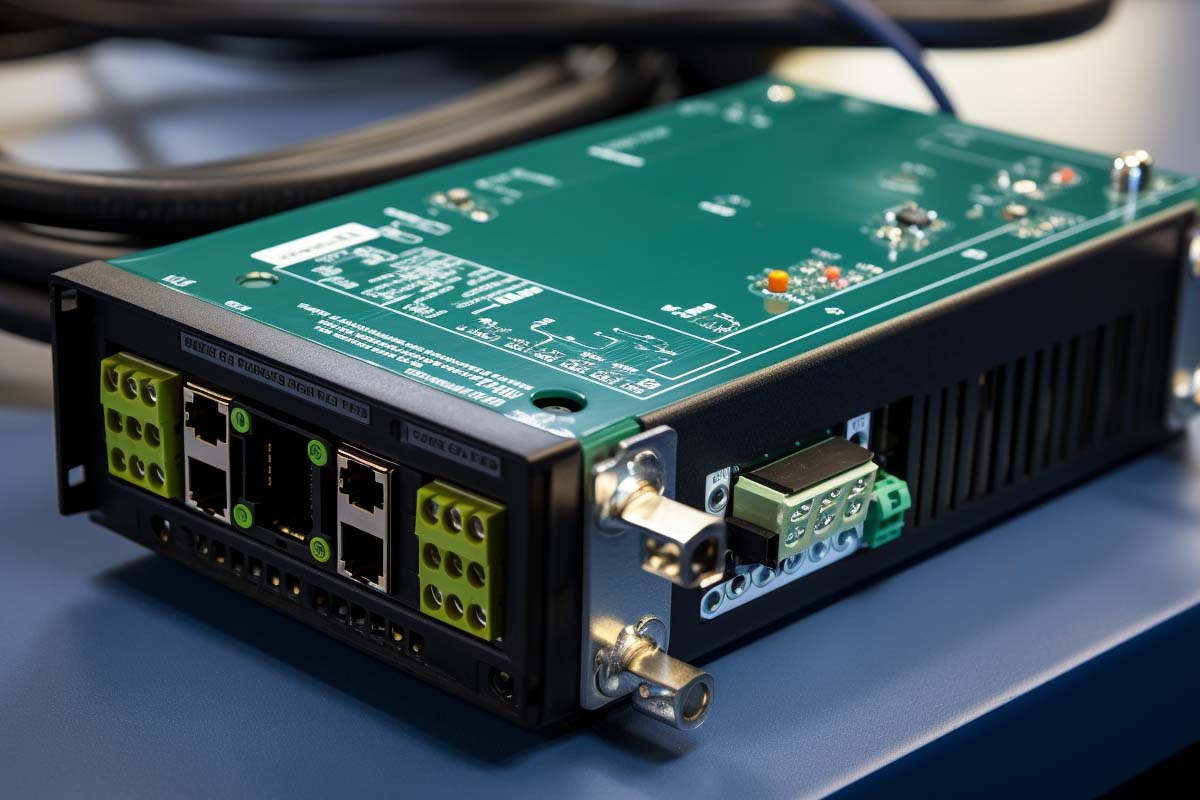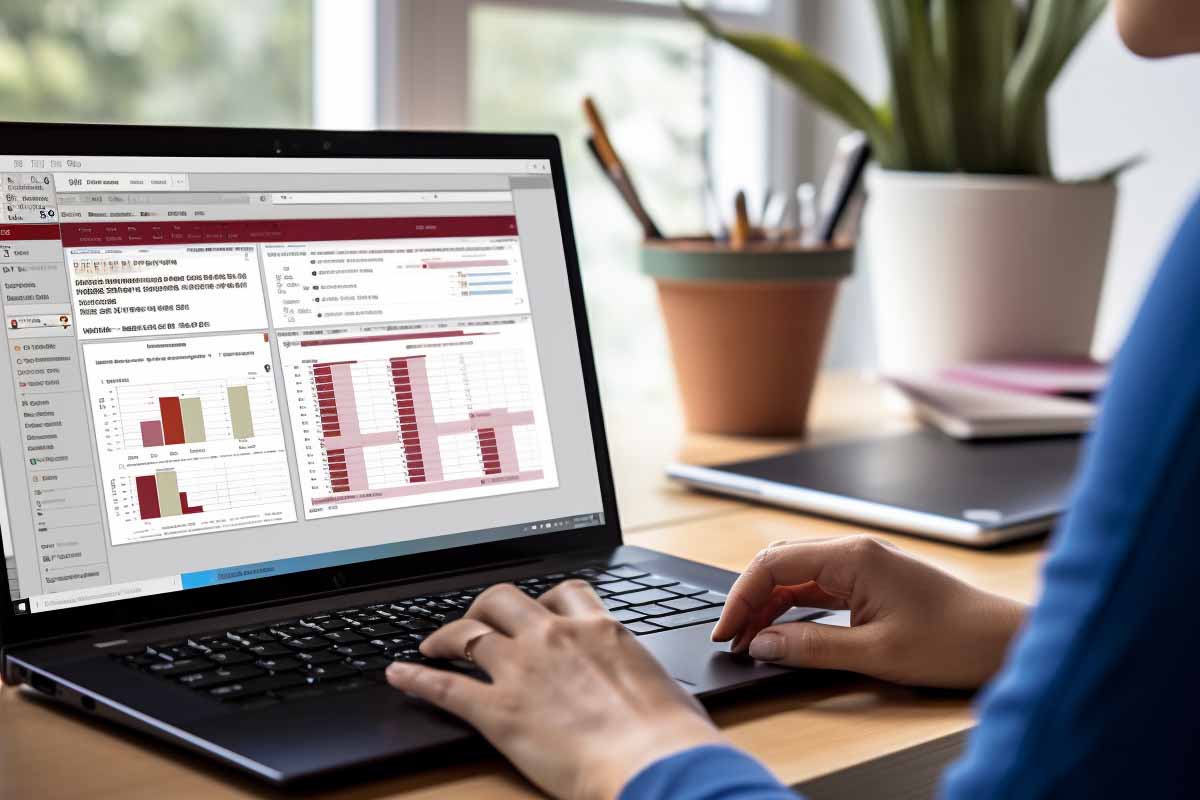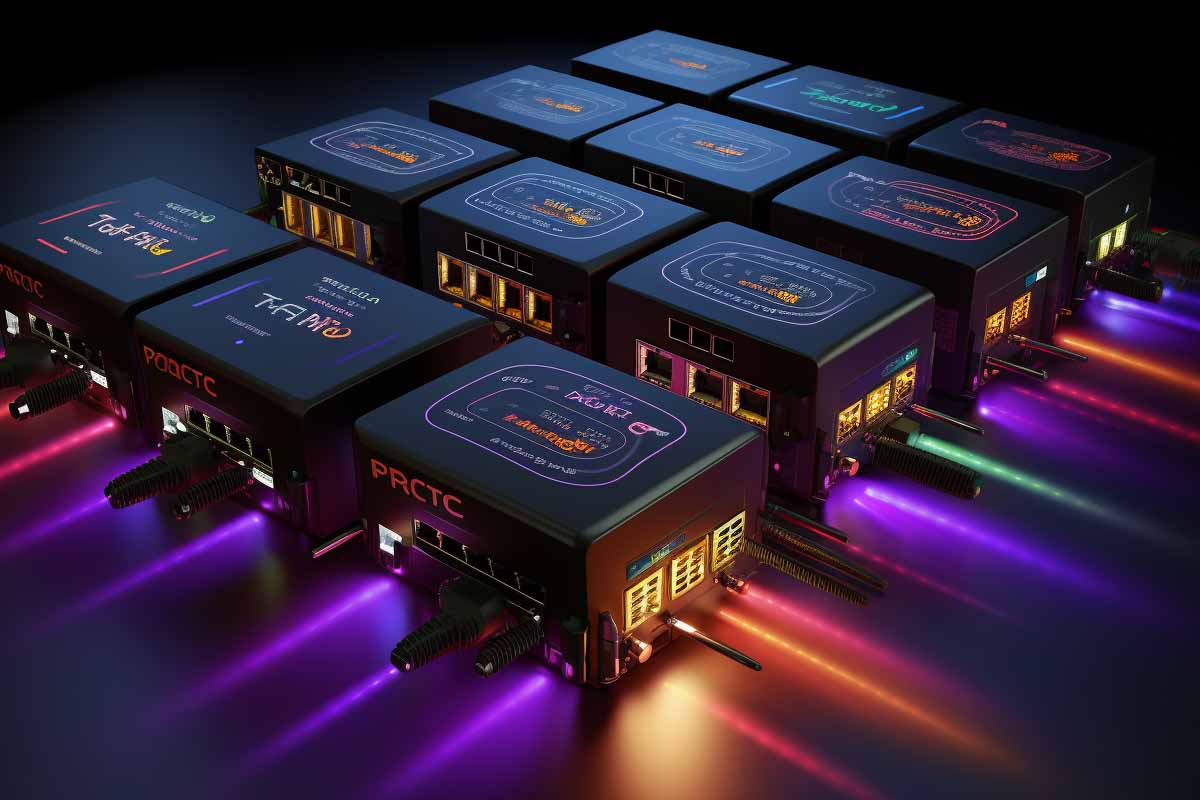Power over Ethernet (PoE) technology is an efficient fusion of power and networking, enabling devices to receive both through a single cable. Central to this system is the PoE switch, a versatile networking tool that streamlines the deployment of networked devices.
Understanding the PoE Switch
A Power over Ethernet (PoE) switch serves as a central power source for multiple network devices. It’s not just any network switch; it’s a sophisticated hub that’s been engineered with built-in PoE injection capabilities. This means it can deliver both power and data through a single network cable to PoE-compliant devices, such as Voice over IP (VoIP) phones, wireless access points (WAPs), and IP surveillance cameras.
The integration of PoE technology within the switch streamlines the entire process of powering and connecting devices. For instance, when setting up a VoIP phone, there’s no need to plug it into a power outlet; the PoE switch provides the necessary power through the Ethernet cable that connects the phone to the network. This significantly reduces the number of cables needed and eliminates the bulky power bricks that would otherwise be required for each device.
Moreover, the consolidation of power into the Ethernet infrastructure via a PoE switch brings a new level of simplicity and cost-efficiency to network design and expansion. It allows for greater flexibility in the placement of network devices, as you’re no longer restricted to areas close to electrical outlets. This is particularly advantageous in challenging installations, such as deploying security cameras in remote locations or installing WAPs in optimal high locations for better signal distribution.
The Versatility of PoE Ethernet Switches
PoE Ethernet switches come in various forms, catering to different network scales and requirements. From small PoE switches designed for home or small business environments to managed PoE switches for enterprise networks, the variety ensures that there is a PoE solution for every scenario.
The versatility of PoE Ethernet switches can be highlighted through a variety of examples that showcase their range of applications, sizes, and management capabilities. Here are some examples:
- Variety in Scale and Size:
- Compact PoE Switches: Ideal for small offices or home networks, where fewer connections are required.
- Rack-Mounted PoE Switches: Designed for data centers and large enterprise networks, offering a higher number of ports and power budgets.
- Diversity in Management Features:
- Unmanaged PoE Switches: Plug-and-play devices suitable for simple networks without the need for configuration.
- Managed PoE Switches: Provide advanced management features like VLANs, QoS, and network monitoring, essential for complex network infrastructures.
- Speed and Performance Options:
- Fast Ethernet PoE Switches: Offer speeds of up to 100 Mbps, sufficient for basic tasks and low-bandwidth devices.
- Gigabit Ethernet PoE Switches: Deliver speeds of up to 1 Gbps per port, suitable for bandwidth-intensive tasks like video conferencing.
- Integration in Various Environments:
- Industrial PoE Switches: Built with durable components and casing to withstand harsh environments and wide temperature ranges.
- Outdoor PoE Switches: Weatherproof and designed to power outdoor devices such as long-range wireless access points and surveillance cameras.
Managed PoE Switches
Managed PoE switches provide advanced features such as the ability to control individual ports, monitor network traffic, and configure VLANs. They are particularly useful in complex networks where granular control over both power and data is required. Managed PoE switches represent a significant advancement in network technology, providing administrators with extensive control and insight into their network operations. These switches are not just power sources; they are comprehensive management tools that offer a suite of features to optimize and secure a network. Here are some key aspects that highlight the versatility of managed PoE switches:
- Remote Management Capabilities: Managed PoE switches can be configured and managed remotely, allowing network administrators to monitor and control the network from anywhere. This remote access is vital for large-scale networks or networks spread across multiple locations.
- Advanced Configuration Options: These switches allow for the configuration of VLANs, QoS (Quality of Service), and network traffic prioritization. By segmenting network traffic, administrators can ensure critical devices get the bandwidth and power they need to operate effectively.
- Enhanced Security Features: Managed PoE switches often come with robust security features, such as access control lists (ACLs), guest VLANs for visitors, and DHCP snooping to prevent unauthorized access to the network.
- Network Monitoring and Diagnostics: They offer comprehensive monitoring tools that provide insights into network performance, traffic statistics, and error reports. This information is crucial for diagnosing issues and ensuring the network is operating efficiently.
- Port-Level Control: Administrators have the power to manage individual ports, enabling or disabling them, setting power priorities, and controlling power allocation. This level of control is essential for optimizing the performance of PoE devices and managing the overall power budget.

IT User Support Specialist Career Path
View our comprehensive training series covering all the key elements and certifications needed to successfully excel in an IT User Support Specialist job role.
Gigabit PoE: High-Speed Connectivity
Gigabit PoE switches are an evolution in the Power over Ethernet landscape, offering not just the convenience of PoE but also the high-speed data transfer capabilities of Gigabit Ethernet. These switches are designed to meet the demands of bandwidth-intensive applications while providing the power to support them directly over the network cable. This dual functionality is essential for modern networks where data speed and uninterrupted power are critical for the performance of connected devices.
High-Speed Data Transfer
Gigabit Ethernet is capable of supporting data transfer rates of up to 1 Gbps (1000 Mbps), which is ten times faster than Fast Ethernet’s 100 Mbps. This high-speed connectivity is particularly important for devices that handle large amounts of data, such as high-definition IP cameras, which require both robust data throughput for video streaming and sufficient power to function.
Enhanced Network Performance
By integrating PoE with Gigabit Ethernet, these switches ensure that network performance is not compromised by power delivery. Devices receive a steady, reliable power supply without sacrificing data transfer speeds, ensuring optimal performance across the network.
Scalable and Efficient Network Solutions
Gigabit PoE switches are scalable solutions that cater to growing business needs. They allow for the addition of new devices without the bottleneck of data transfer speeds or power availability, making them a future-proof investment for expanding networks.
Here is a table comparing different Ethernet speed levels and their practical applications:
| Ethernet Standard | Speed | Power (PoE Standard) | Practical Applications |
|---|---|---|---|
| Fast Ethernet | 10/100 Mbps | Up to 15.4W (802.3af) | VoIP phones, basic surveillance cameras, sensors |
| Gigabit Ethernet | 1000 Mbps | Up to 30W (802.3at) | HD surveillance cameras, high-speed WAPs, networked storage |
| 10 Gigabit Ethernet | 10 Gbps | Up to 60-100W (802.3bt) | Data centers, large-scale deployments, high-performance computing environments |
*Note: The power output depends on the PoE standard supported by the switch and not just the Ethernet speed standard.
Practical Applications of Gigabit PoE
The practical applications of Gigabit PoE are vast and varied. Here are a few examples where the combination of high-speed data and power over Ethernet is particularly beneficial:
- Surveillance Systems: High-definition IP cameras require a lot of bandwidth for video transmission, which Gigabit PoE can provide, along with the power the cameras need.
- High-Density Wi-Fi Access Points: In areas with a high concentration of users, such as conference centers or universities, Gigabit PoE can support WAPs that need to handle multiple high-speed connections simultaneously.
- VoIP and Conferencing Systems: Advanced VoIP handsets and video conferencing systems benefit from the clear, lag-free communication enabled by Gigabit speeds, with the convenience of being powered over the same cable.
- Networked Storage Solutions: NAS devices that serve multiple users benefit from Gigabit PoE switches, as they require fast data access speeds and often need to be placed in locations where power outlets are not readily available.
- Smart Building Infrastructure: For smart buildings that integrate IoT devices, Gigabit PoE can power and connect a multitude of sensors and controllers that require real-time data transmission for building management systems.
The use of Gigabit PoE switches is a clear indicator of a network’s readiness for the future, accommodating the increasing demands for power and high-speed data within a single, efficient infrastructure.
Ensuring Optimal Performance with Ethernet Switches with PoE
Ensuring optimal performance with Ethernet switches that have Power over Ethernet (PoE) capabilities involves several critical steps. Here are the key measures you should take:
- Assess Power Requirements:
- Calculate the total power draw of all PoE devices to ensure the switch can provide adequate power.
- Ensure the switch’s power budget exceeds the cumulative power needs of connected devices.
- Evaluate Bandwidth Needs:
- Determine the data throughput required by your devices.
- Select a switch with sufficient backplane bandwidth to handle peak traffic without bottlenecks.
- Plan for Future Expansion:
- Choose a switch with more PoE ports than currently needed to allow for network growth.
- Consider the potential for increased power demands from future PoE devices.
- Understand PoE Standards:
- Match your devices with a switch that supports the appropriate PoE standard (e.g., IEEE 802.3af/at/bt).
- Consider newer standards for higher power needs and ensure backward compatibility for older devices.
- Network Design and Layout:
- Minimize cable lengths to prevent voltage drops, which can be crucial for PoE performance.
- Use quality cabling that meets or exceeds the category necessary for your PoE devices, typically Cat5e or higher.
- Quality of Service (QoS) Configuration:
- Prioritize traffic to ensure that critical applications receive the bandwidth they require.
- Configure QoS settings on the switch to prioritize real-time traffic such as VoIP and video streaming.
- Switch Firmware Updates:
- Keep the switch firmware up-to-date to ensure the latest features and security patches are applied.
- Regular updates can also improve the switch’s performance and compatibility with devices.
- Implement VLANs:
- Use Virtual Local Area Networks (VLANs) to segment traffic and reduce unnecessary data on PoE-powered devices.
- Isolate sensitive devices to VLANs to minimize the risk of overload and optimize performance.
- Proper Ventilation and Cooling:
- Ensure that the PoE switch is in a well-ventilated area to prevent overheating, which can affect performance.
- Consider additional cooling measures in environments with high power demands.
- Monitor Network Performance:
- Regularly monitor the network’s performance using built-in switch diagnostics or external monitoring tools.
- Look out for anomalies in traffic patterns or power consumption that might indicate issues.
- Deploy Uninterruptible Power Supplies (UPS):
- Connect PoE switches to a UPS to ensure power continuity during outages, which is crucial for devices that require constant uptime.
- Routine Maintenance:
- Schedule regular maintenance checks to inspect the hardware and connections.
- Replace any faulty cables and ensure connectors are secure to maintain optimal data and power transmission.
By following these steps, you can maximize the efficiency and reliability of your network, ensuring that your PoE-enabled devices operate at peak performance.

Lock In Our Lowest Price Ever For Only $14.99 Monthly Access
Your career in information technology last for years. Technology changes rapidly. An ITU Online IT Training subscription offers you flexible and affordable IT training. With our IT training at your fingertips, your career opportunities are never ending as you grow your skills.
Plus, start today and get 10 free days with no obligation.
The Efficiency of a Powered Switch
A powered switch, particularly one powered by PoE, refers to a switch that can receive its operating power over the Ethernet cable from another PoE device, such as a PoE injector or another switch. This capability allows for greater flexibility in switch placement and can help reduce installation costs.
Simplified Infrastructure
A PoE-powered switch reduces the need for additional electrical wiring by allowing Ethernet cables to carry both data and power to networked devices. This simplification not only saves on installation costs but also on the materials and space used in an office or data center environment.
Intelligent Power Allocation
Modern PoE switches are smart enough to manage power allocation efficiently. They can detect the exact power needs of connected devices and supply the right amount of power, ensuring that no energy is wasted. This capability also prevents overloading of the network switch by avoiding the supply of excessive power that the devices cannot handle.
Remote Power Management
The ability to remotely power cycle individual ports on a PoE switch adds to its efficiency. Network administrators can reboot devices from a central location without having to physically interact with them, which saves time and reduces the need for on-site interventions. This feature is especially useful in managing devices located in hard-to-reach areas.
Reduced Energy Consumption
Many PoE switches come with energy-efficient features that help reduce overall power consumption. Features like time-based PoE, which allows administrators to set schedules for when PoE ports are active, ensure that power is used only when necessary, reducing energy waste during off-hours.
Centralized Power Source
Having a centralized power source for multiple devices helps in better energy monitoring and management. It is easier to manage and maintain a single power source – the PoE switch – than to oversee numerous wall adapters and power outlets. Centralizing power through a PoE switch can also lead to cost savings in power usage, as it’s typically more energy-efficient than having multiple power adapters.
Advanced Energy-Efficient Ethernet (EEE)
PoE switches that support the Energy-Efficient Ethernet (EEE) standard can reduce power consumption during periods of low data activity. The switch can dynamically adjust power usage based on the actual network traffic, which is a significant step towards greener networking practices.
Lifecycle Management
The longevity of network devices is extended when using a PoE switch because it prevents the potential electrical damage that can occur with multiple power adapters. Additionally, managing the power supply from a central point can increase the lifecycle of the switch itself, as it is often designed to handle the load efficiently.
Scalability
As network requirements grow, PoE switches allow for easy scalability. Additional PoE-capable devices can be added without the concern for new power sources, and the PoE switch can continue to manage power efficiently across all connected devices.
In summary, a PoE-powered switch is a paragon of efficiency in modern networking. It consolidates power distribution, reduces cabling complexity, and offers intelligent energy management, all of which contribute to a streamlined, cost-effective, and environmentally friendly network infrastructure. These switches are designed to adapt to the needs of a wide array of PoE devices, from the simplest sensors to the most demanding data-driven devices, making them an indispensable component in both small-scale and large-scale network environments.
Choose Your IT Career Path
ITU provides you with a select grouping of courses desgined specfically to guide you on your career path. To help you best succeed, these specialized career path training series offer you all the essentials needed to begin or excel in your choosen IT career.
Frequently Asked Questions Related to PoE Switches
What is a PoE switch and how does it work?
A PoE (Power over Ethernet) switch is a network switch that has the ability to deliver power over Ethernet cables along with data to PoE-enabled devices, such as IP cameras and wireless access points. It works by detecting the presence of a compliant device, determining its power requirements, and then supplying power through the Ethernet cable.
Can non-PoE devices be connected to a PoE switch?
Yes, non-PoE devices can be connected to a PoE switch without any risk of damage. The switch will detect that the connected device is not PoE-capable and will only transmit data to it, not power.
What’s the difference between a managed and an unmanaged PoE switch?
A managed PoE switch allows for greater control over the network and the devices connected to it, offering features like VLAN setup, network traffic prioritization, and remote management. An unmanaged PoE switch is plug-and-play, with no ability to configure settings or manage network traffic, providing power and data on the same network without any modifications.
How do I determine the power budget I need for a PoE switch?
To determine the power budget for a PoE switch, add up the maximum power draw of all the PoE devices you plan to connect to the switch. Ensure the total does not exceed the switch’s total PoE power budget, which is the maximum amount of power the switch can provide to all devices.
What are the PoE standards and why do they matter?
PoE standards, such as IEEE 802.3af, IEEE 802.3at, and IEEE 802.3bt, define the amount of power that can be delivered over Ethernet cables. These standards matter because they ensure interoperability between devices and switches from different manufacturers and determine the type and number of devices you can power with your PoE switch. The standards also provide safety mechanisms to protect both the powered devices and the power sourcing equipment.

























